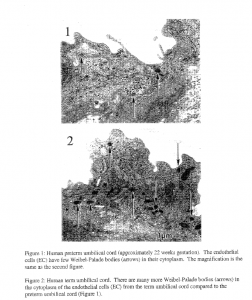Niloufar Tabatabeai and Dr. John S. Gardner, Botany & Range Science
Newbom, premature infants have greater susceptibility to infection compared to older newborn infants. Although the reason for greater susceptibility to bacterial infection in premature infants is unknown, there are many reports that focus on neutrophils as the defective cell type in the immature neonatal system. However, it was recently reported by Lorant et al. that in a rat model of inflammation, neutrophils from adult rats failed to migrate efficiently in neonatal rats.’ Furthermore, we found that this defect was associated with decreased expression of Pselectin on the surface of neonatal endothelial cells in situ.
It was hypothesized that endothelial cell P-selectin expression would be less in human umbilical cord veins from prematurely born (preterm) infants compared to normal term infants. To test this hypothesis, we collected umbilical cords from preterm infants (38 weeks gestation). These umbilical cords were used for transmission electron microscopy for the identification of Weibel-Palade bodies, the storage organelle for P-selectin. Fresh umbilical cords were cut in cross -section, fixed with 2.5% glutaraldehyde and 1% paraformaldehyde in cacodylate buffer, post-fixed with 1% osmium tetroxide, and embedded in epoxy resin. Thin-sections were cut across the umbilical vein’s endothelial cells, counterstained with uranyl acetate and lead citrate, and observed with an Hitachi H-7 I 00 transmission electron microscope. We evaluated umbilical cords from seven preterm and seven term infants in this way.
Weibel-Palade bodies were ultrastructurally identified as small, electron-dense, membranebound organelles that were located in the cytoplasm of the umbilical cord endothelial cells. Few Weibel-Palade bodies were present in the endothelial cells of the preterm (22 to 26 wks) infants (Figure 1). By contrast, the term (39 to 40wks) infants had numerous Weibel-Palade bodies (Figure 2). Statistical analysis revealed that the numerical density of Weibel-Palade bodies as 0. I 16±0.170/@iM3 for preterm and 0.374±0.253/gM3 for term infants. The dimensions of the Weibel-Palade bodies did not vary significantly between the preterm and term infants.
This experiment demonstrates that endothelial cells from preterm infants have fewer Weibel- Palade bodies and therefore there is less P-selectin expressed in the preterm than the term infants. We speculate that the decreased P-selectin expression in preterm neonates may contribute to delayed neutrophil adhesion and migration in vivo, thereby contributing to greater susceptibility to infection.
References
- DE Lorant et al. Pediatric Res 39 (1996) 295A.
- H Kagawa and S Fujimoto. Cell and Tissue Res 249 (1987) 557.

